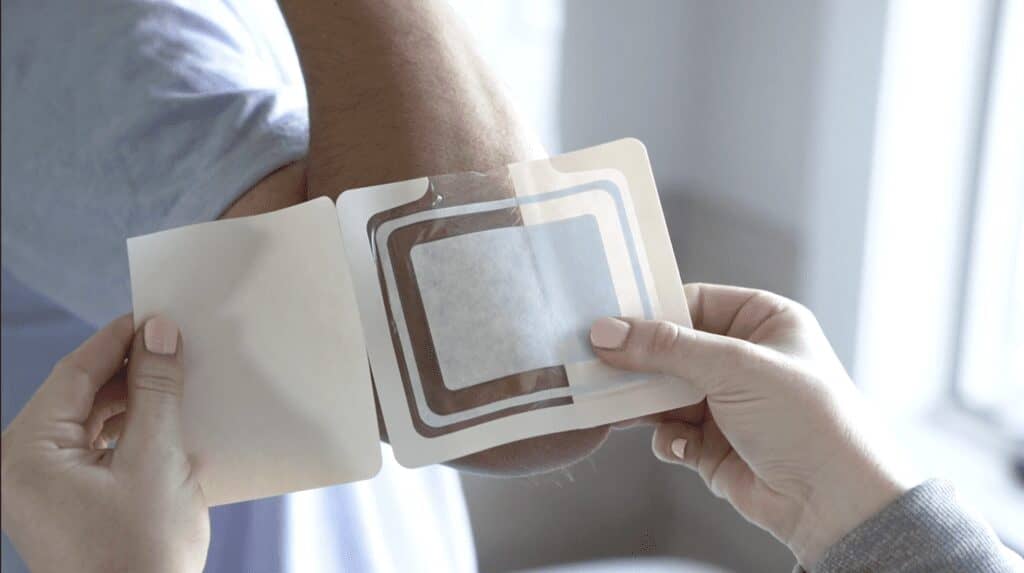DrySee technology is designed to alert post-procedure patients when it’s time to change their bandage. It’s also formulated to protect fresh ink on a new tattoo, or shield fragile skin during the tattoo removal and healing process.
By Tonya Johnson
DrySee, a medical technology company aimed at improving wound care, recently introduced its patented waterproof bandage with liquid intrusion alert. After surgical procedures, most doctors typically recommend that patients avoid showering to keep an incision area dry. But, according to the company, patients who use DrySee can shower and go about their daily lives without worrying about their wound, because they will be visually alerted if any liquid penetrates the bandage.
A DrySee can be applied during the healing process of incisions related to plastic surgery procedures such as reconstruction, abdominoplasty, breast augmentation or reduction, skin removal, and scar revisions. However, Brad Greer, DrySee’s chief executive officer, also notes: “We’ve also had some promising feedback from tattoo artists as well as dermatologists who specialize in tattoo removals. It’s a great product to protect fresh ink as a new tattoo heals, or to protect the fragile skin during the removal and healing process.”
Sarah Whitlow, a medical esthetician and trained laser technician, has provided tattoo removal service for 13 years at Village Dermatology in Houston, Texas. In fact, tattoo removal service makes up about 10% of the business.
Plastic Surgery Practice interviewed Greer and Whitlow to learn more about the latest in wound care technology and the specific benefits it has for tattoo clients.
Plastic Surgery Practice: What makes DrySee unique in today’s marketplace?
Brad Greer: DrySee is the only waterproof bandage with a liquid indicator. This visual alert allows patients to shower sooner with confidence. For plastic surgery patients, the product promotes safe bathing during post-op. With a DrySee, you can see if the bandage is secure or if it has been compromised. The patient can watch the bandage for a color change, then replace it when needed. This reduces the amount of unnecessary bandage changes and wound exposure during those changes. Being able to self-monitor your dressing decreases in-person return visits to the doctor to check the status of a wound or dressing.
PSP: What do your patients like most about DrySee?
Sarah Whitlow: They like that they don’t have to change a bandage every day, and if they want to go swimming, it’s not an issue.
PSP: Explain the healing process for tattoo removal and why it’s so crucial?
Whitlow: With a DrySee bandage, it typically takes five to seven days initially, and sometimes a full 14 days depending on the tattoo area treated. The healing process is very important because if the area doesn’t heal properly, there is a higher risk of scarring and then full clearance of the tattoo will not be achieved.
To heal properly and prevent infection after tattoo removal, patients should: keep the treated area clean, covered, and stay out of the sun. Also, continue to apply healing ointment, and avoid open bodies of water when swimming, due to increased risk of infection, for at least one week.
PSP: How often does a DrySee bandage need to be changed?
Greer: A DrySee bandage will last until it becomes compromised — typically within three to five days. With the color changing liquid indicator, you can see when it’s time to change your bandage.
PSP: What type of product upgrades would you like to see in the marketplace for patients as it relates to incision care and the post-procedure healing process?
Whitlow: I’m always excited to see new products enter the market that will help patients heal faster and easier. The rolling trend from patients right now seems to be: “I want results, I want them today and no down time!” So, anything that aids in that process is always great to have available.
PSP: What’s next for DrySee?
Greer: In addition to developing products that help promote self-care and remote care, we are currently in the developmental stages of a high absorbency foam product with a saturation indicator which will allow us to provide superior bandages to the chronic wound market. DrySee is working to introduce an anti-microbial foam bandage in 2022.
Tonya Johnson is associate editor at Plastic Surgery Practice.







